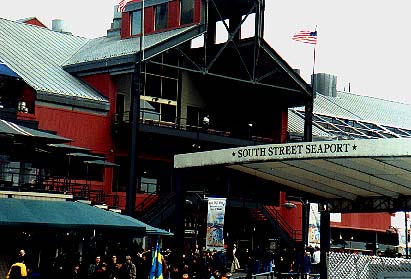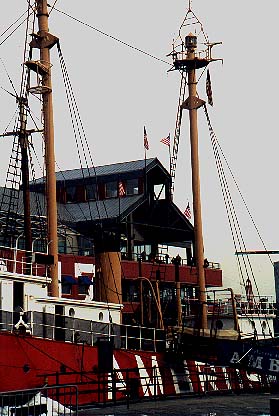New York City:
South Street Seaport
From China clippers, Long Island Sound steamboats and trans-Atlantic cargo ships of the 17th and 18th century, to present day shops, restaurants and museums, the South Street Seaport has remained a key ingredient to the success of New York City.
Historically, this Seaport located on the East River dates back over 300 years to the 16th century. Throughout this time, the most important role of the South Street Seaport was its usage as a gateway to New York City. Through this gateway, goods were shipped to and from many parts of the country and all over the world. The active shipping industry of this East River port ignited the development and construction of new buildings, taverns and warehouses along the waterfront. Soon, this area became one of the most vital commercial centers in New York City.
During the mid 1860’s, South Street Seaport began to deteriorate. Many shipping lines left the port for larger ones located along the Hudson River. The once-thriving port had become abandoned, save a couple of remaining shipping lines and the Fulton Fish Market. The area remained to be a relatively deserted seaport for many decades to follow.
 It was during the 1960’s that lower Manhattan began to experience great change. The business district of the Wall Street area, also known as the "financial district", was expanding. With the expansion and growth of the financial district came new residential and commercial developments in lower Manhattan. The time had come for the revitalization of the complete lower Manhattan sector.
It was during the 1960’s that lower Manhattan began to experience great change. The business district of the Wall Street area, also known as the "financial district", was expanding. With the expansion and growth of the financial district came new residential and commercial developments in lower Manhattan. The time had come for the revitalization of the complete lower Manhattan sector.
The Rouse Company of Colombia, Maryland became interested in including the South Street Seaport in the revitalization effort taking place in lower Manhattan. The goal of the revitalization of the seaport was to give the urbanites of Manhattan an escape from the city. To create a much less frenzied atmosphere, the streets that originally ran through the seaport were closed off to all motorized traffic. The streets were then paved with cobblestones. This created an environment that welcomed the leisurely stroll of the pedestrian. The abandoned buildings and warehouses that were once important to this seaport became necessary once again. These historic buildings were renovated and quickly became occupied by numerous specialty shops and restaurants.
Today, the South Street Seaport is bustling with just as much commercial and retail activity as it was, historically, with shipping activity. The South Street Seaport Museum opened in 1967 and has helped preserve the historic seaport district. Important parts of the museum include the historical buildings that line the streets and the ships, also known as the "Street of Ships", that are actually docked at the port.
 The Pier 17 Pavilion has been constructed at the site of one of the fish market’s oldest piers. The pier has since been reconstructed, allowing the three-story pavilion to extend into the East River. The Pier 17 Pavilion is filled with a variety of retail establishments and restaurants.
The Pier 17 Pavilion has been constructed at the site of one of the fish market’s oldest piers. The pier has since been reconstructed, allowing the three-story pavilion to extend into the East River. The Pier 17 Pavilion is filled with a variety of retail establishments and restaurants.
The Fulton Market Building was constructed in 1983. It is home to restaurants and private gathering facilities. The remainder of the building is presently being extensively renovated.
The revitalization of the South Street Seaport has resulted in a historic district filled with pieces of New York City’s nautical past. The seaport creates the opportunity to catch a glimpse of what the city was like years ago and to interact with actual pieces of history. The South Street Seaport is alive with the bustling activity of urbanites, tourists and commerce once again.
References:
"South Street Seaport." http://www.southstseaport.org/index.htm
"South Street seaport-New York." http://access.tampabayrpc.org/waterfront/southstreet.htm
"Virtual Tour-South Street Seaport." http://articles.citysearch.com/New-York/virtualtour/seaport/index.html
Siers, Greg. Telephone interview. 3 March 1999.
Page Author: Sarah Johnson
.


 It was during the 1960’s that lower Manhattan began to experience great change. The business district of the Wall Street area, also known as the "financial district", was expanding. With the expansion and growth of the financial district came new residential and commercial developments in lower Manhattan. The time had come for the revitalization of the complete lower Manhattan sector.
It was during the 1960’s that lower Manhattan began to experience great change. The business district of the Wall Street area, also known as the "financial district", was expanding. With the expansion and growth of the financial district came new residential and commercial developments in lower Manhattan. The time had come for the revitalization of the complete lower Manhattan sector.
 The Pier 17 Pavilion has been constructed at the site of one of the fish market’s oldest piers. The pier has since been reconstructed, allowing the three-story pavilion to extend into the East River. The Pier 17 Pavilion is filled with a variety of retail establishments and restaurants.
The Pier 17 Pavilion has been constructed at the site of one of the fish market’s oldest piers. The pier has since been reconstructed, allowing the three-story pavilion to extend into the East River. The Pier 17 Pavilion is filled with a variety of retail establishments and restaurants.